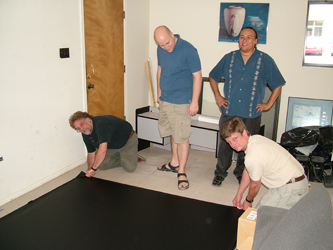 The Scientific Computing and Visualization group within Information Services & Technology at Boston University is partnering with the Department of Native American Studies, the High Performance Computing Center and the Computer Science Department at the University of New Mexico; the Department of Education at the Pueblo of Jemez; and the Walatowa High Charter School in an innovative educational research project designed to increase diversity in the computing disciplines. The project, New Voices and New Visions, is specifically aimed at increasing the number of Native Americans studying computer science at the high school and undergraduate college levels, as well as pursuing careers in computer related fields. The program is funded by the National Science Foundation’s CISE Directorate under Broadening Participation in Computing (Grant No. CNS-0540484) which strives to increase diversity in the computing disciplines, particularly among underrepresented groups, women, minorities and persons with disabilities.
The Scientific Computing and Visualization group within Information Services & Technology at Boston University is partnering with the Department of Native American Studies, the High Performance Computing Center and the Computer Science Department at the University of New Mexico; the Department of Education at the Pueblo of Jemez; and the Walatowa High Charter School in an innovative educational research project designed to increase diversity in the computing disciplines. The project, New Voices and New Visions, is specifically aimed at increasing the number of Native Americans studying computer science at the high school and undergraduate college levels, as well as pursuing careers in computer related fields. The program is funded by the National Science Foundation’s CISE Directorate under Broadening Participation in Computing (Grant No. CNS-0540484) which strives to increase diversity in the computing disciplines, particularly among underrepresented groups, women, minorities and persons with disabilities.
At the core of the project is the development and delivery of a new, two-semester, interdisciplinary course, Art and Computation. The course introduces computer science using an approach that combines Native American culture and art with a high-technology, computer-rich environment as an innovative means of engaging Native American students. Within a framework of art and culture, the course exposes students to a rich set of computational applications. The course covers topics in digital media, computer programming, computer graphics, virtual reality, 3D modeling, animation, and distributed computing. During the year the students work with Native American artists in creating an innovative project that uses indigenous pedagogy to learn computer science principles and to produce a publicly viewable work of art. The approach is to motivate the computer science concepts as the empowering underpinning for a culturally and artistically rich experience.
The capstone of the course is the design and creation of a virtual reality experience which integrates Native American storytelling, iconography and sounds. Key components of the course are the use of the SCV-developed DAFFIE Virtual Environments system and Deep Vision Display (DVD) Wall. These technologies create an environment that is rich in computer science concepts, as well as compelling at the experiential level, to create a context and motivation for the educational experience. Additionally, Access Grid video conferencing technology is used as the main communication infrastructure for the project. The University’s Access Grid node is being used to create the virtual classroom between UNM and Boston University for the course, as well as for tutorials, researcher and technical staff meetings, meetings with the students and artists, etc. As part of this project, SCV staff traveled to UNM and to the Jemez Pueblo to install the DAFFIE and DVD Wall systems and to train the teachers and staff in their use.
This project builds on a long history of successful collaborations between BU’s SCV group and the University of New Mexico, as well as SCV’s HiPArt outreach program. BU and UNM collaborated for more than six years (1998-2005) as Partners for Advanced Computational Services with NCSA in the NSF funded PACI program. BU SCV and UNM were among the first groups to build Access Grid nodes and to collaborate over the Access Grid, working together on the Alliance Chautauqua conferences in 1999. In 2004, an NSF Small Grant for Experimental Research funded a pilot project for supporting AG use in Minority Serving Institutions, as a collaboration between SCV staff and the Minority Serving Institutions Network; this project included visits to a number of sites, including the UNM-led Tribal Virtual Network, which led to a co-authored paper presented at the 2005 AG Retreat.
